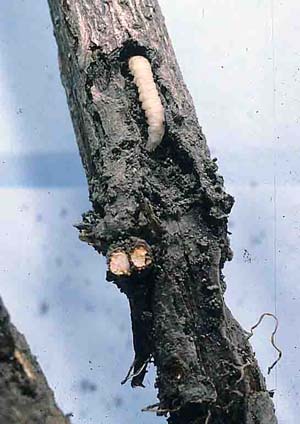Viburnum Crown Borers | |
|---|---|
| May 22, 2007 | |
|
Viburnum crown borers are several species of clearwing moth borers that attack at the base of viburnum shrubs. Younger plants and those that have just been transplanted or put under similar stress appear to be more susceptible to attack. Vibrurnum opulus, particularly Vibrunum opulus compacta, appears to be considerably more susceptible to attack than other species. Commonly, new plantings of Viburnum opulus compacta are severely attacked, resulting in severe dieback and even the death of half or more of the planting. Other species of Viburnum are attacked but are usually not severely damaged. Larvae tunnel in the cambium just under the bark, primarily from the soil surface to 6 to 8 inches belowground. Heavily attacked belowground stems are deeply furrowed by larval tunneling, with very little if any bark remaining. The fully grown white, legless larvae are about 1 inch long and 1/4 inch in diameter. They are easily located in the shallow tunnels. Heavily attacked shrubs have dead stems that break off easily from the crown. Moths emerge through round holes about 3/16 inch in diameter on the stems just above the soil line. Several-year-old emergence holes can commonly be found at the base of older, healthy viburnums of several species, indicating that they were attacked early in life but survived. Control is achieved by applying permethrin (Astro) to the base of the plant when beautybush and mock orange bloom. Beautybush is blooming at this time in central Illinois, so application at this time in southern and central Illinois is warranted. Application in northern Illinois should occur in a couple of weeks. Spray heavily onto the bark at the base of the plant. This provides complete coverage and allows the insecticide to run down onto the belowground portion of the stem. Because the larvae feed shallowly on the stem below ground and many are exposed to the soil, the insecticidal nematode Heterorhabditis bacteriophora is effective in late August against these larvae. Apply the nematodes to moist soil and keep it moist so that the nematodes do not dry out and die. �� | |
| Author: | Phil Nixon |

